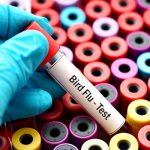 With human infections from a bird flu virus surging in China, US officials charged with preparing the country for influenza pandemics have been assessing the state of an emergency stockpile of vaccines against that strain. The conclusion: The stored H7N9 vaccine doesn’t adequately protect against a new branch of this virus family, and a new vaccine is needed.
With human infections from a bird flu virus surging in China, US officials charged with preparing the country for influenza pandemics have been assessing the state of an emergency stockpile of vaccines against that strain. The conclusion: The stored H7N9 vaccine doesn’t adequately protect against a new branch of this virus family, and a new vaccine is needed.
Rick Bright, who heads the Biomedical Advanced Research and Development Authority, or BARDA, said the H7N9 vaccine in the stockpile would not fend off a new family of these viruses that has emerged in China, known as the eastern or Yangtze River Delta lineage of the viruses.
The conclusion comes amid a sharp rise in human H7N9 infections this winter in China. There have been 460 cases reported since last fall — a third of the 1,258 H7N9 infections diagnosed since the virus was first spotted in early 2013. In addition, the virus has spread more broadly across the country, increasing the chances more people will be infected in future.
Adding to the concern is the fact that the virus is evolving and has essentially split into two groups that are now different enough that vaccine for one might not protect very well against viruses from the other. The US stockpile currently contains enough vaccines to inoculate about 12 million people against the older lineage of H7N9, the southern or Pearl River Delta viruses.
“The antibodies [generated by the stockpiled vaccine] now appear to be suboptimal in their reactivity to these new eastern lineage viruses. So that means we will need to make new vaccine that will induce an immune response that will be cross-reactive and neutralize this new lineage of viruses,” Bright said.
The vaccines in the pandemic flu stockpile are intended to protect first responders in the case one of the highest-risk bird flu viruses triggers a pandemic. BARDA’s policy is to maintain enough vaccine for each of these top threats to be able to vaccinate 20 million people. As each person would need both a primer and a booster dose, that means 40 million doses of vaccine for each viral threat.
The costs of producing that much vaccine is roughly $100 million, Bright said. Because vaccines against bird flu viruses don’t typically induce a strong immune reaction in people, they must be administered with an adjuvant, a compound that heightens the immune response. The adjuvant needed for this much vaccine adds roughly $100 million to the cost, he said.
Currently the stockpiled supplies of H7N9 are lower than they ought to be. Bright said some of the vaccine doses made when the vaccine was ordered in 2013 degraded and had to be discarded.
BARDA must now decide whether it needs to make a full order of vaccine to protect against the new H7N9 viruses and replenish the stores of the older vaccine. But a less expensive solution may be within reach, Bright noted.
Experts who advise the World Health Organization on which flu viruses should be used for seasonal and pandemic flu vaccines have been meeting this week in Geneva. Bright said there have been indications that some H7N9 viruses may be what’s called cross-reactive — if used in a vaccine, they may protect against both lineages of H7N9 viruses.
“We’re very hopeful that they will be able to identify a single or a few CVVs” — candidate vaccine viruses — “that will allow us to make vaccine that will cross-react against all of the H7N9 viruses, thereby reducing the amount of effort and of course cost that it would take to make sure that we are property prepared for H7N9,” Bright said.
The stockpile also contains several versions of vaccines against H5N1 bird flu viruses, the oldest of which was made about a decade ago.
All these vaccines are tested annually to make sure they are still potent. Until the United States began to stockpile pandemic vaccine, it was not known how long vaccine could be stored. Flu viruses evolve so often that leftover seasonal flu vaccine is not saved for use the following year. In fact, the terms of their licenses require that vaccines that are not used within the season for which they are made must be discarded.
Bright said BARDA is working with scientists at the University of Cambridge in Britain to try to figure out how to maximize use of the stored vaccine, conducting tests to see whether giving people different versions of a vaccine — an older and a newer H5N1 vaccine, for instance — could give people both effective and broader protection again the viruses in that family.
“We might still find there’s great value in that investment,” he said of the older vaccines in the stockpile.
Source: STAT News

















